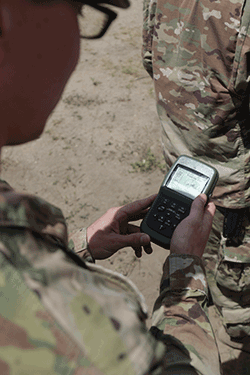
A Soldier with the Ohio National Guard’s 137th Signal Company checks his location on an AN/PSN-13 Defense Advanced GPS Receiver (DAGR). |
CAMP GRAYLING JOINT MANEUVER TRAINING CENTER, Mich. (06/23/18) — Knowing your location and the location of the enemy is paramount on the battlefield, and with the advent of satellites and GPS, U.S. Soldiers can pinpoint their exact position down to the meter. What happens when that signal is jammed?
Ohio National Guard Soldiers are training with a team from the U.S. Army Space and Missile Defense Command, Army Strategic Command (USASMDC/ARSTRAT) on how to identify and mitigate electronic warfare that targets GPS systems.
“There are adversaries out there with the capability to deny, degrade and disrupt our capabilities,” said Capt. Kyle Terza, chief of home station training for USASMDC. “The threat is out there and, while we may not be facing it right now, if we are looking towards the future, we have to be trained and ready to operate without it.”
Terza’s team provides training and resources to both Soldiers maintaining communication and data networks and Soldiers out in the field who are most likely to encounter electronic warfare.
“We’ve been so focused on counterinsurgency, it’s good to train for dealing with adversaries with comparable technologies,” said Staff Sgt. Matthew Merzke, a squad leader with the 1487th Transportation Company, located in Piqua, Ohio. “It’s out there and we need to know how to deal with it.”
Most Soldiers are familiar with the Defense Advanced GPS Receiver (DAGR), commonly referred to as a '"dagger." It's a hand-held GPS receiver that is used in conjunction with many Army systems such as satellite receivers and battlefield command systems, but how they work is a mystery to many.
“A majority of our younger Soldiers have probably never even heard of electronic warfare or have been exposed to it,” Terza said. “It was a great training opportunity for them.”
Soldiers were able to get hands-on with their DAGRs, learning how to recognize when they were being jammed and how to mitigate the electromagnetic interference (EMI). With the team from USASMDC offering guidance, Soldiers were able to triangulate and find the device that was blocking their signals.
“This is stuff we need to know to be able to train better Soldiers,” Merzke said, “to keep them safe and bring them home alive.”
By the end of the training, Soldiers had laid the groundwork to take the instruction back to their units to help other understand the challenges and how to adapt.
“They understand how to recognize it, how to report it and who to report it to.” Terza said. “If they do enter a contested environment, they are prepared for it.” |